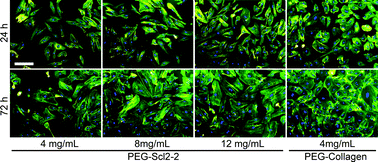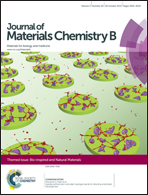Collagen-mimetic hydrogels promote human endothelial cell adhesion, migration and phenotypic maturation†
Abstract
This work evaluates the response of human aortic endothelial cells (HAECs) to thromboresistant collagen-mimetic hydrogel coatings toward improving the biocompatibility of existing “off-the-shelf” small-caliber vascular grafts. Specifically, bioactive hydrogels – previously shown to support α1/α2 integrin-mediated cell adhesion but to resist platelet activation – were fabricated by combining poly(ethylene glycol) (PEG) with a 120 kDa, triple-helical collagen-mimetic protein (Scl2-2) containing the GFPGER adhesion sequence. Analysis of HAECs seeded onto the resulting PEG-Scl2-2 hydrogels demonstrated that HAEC adhesion increased with increasing Scl2-2 concentration, while HAEC migration rate decreased over this same concentration range. In addition, evaluation of HAEC phenotype at confluence indicated significant differences in the gene expression of NOS3, thrombomodulin, and E-selectin on the PEG-Scl2-2 hydrogels relative to PEG-collagen controls. At the protein level, however, only NOS3 was significantly different between the PEG-Scl2-2 and PEG-collagen surfaces. Furthermore, PECAM-1 and VE-cadherin expression on PEG-Scl2-2 hydrogels versus PEG-collagen controls could not be distinguished at either the gene or protein level. Cumulatively, these data indicate the PEG-Scl2-2 hydrogels warrant further investigation as “off-the-shelf” graft coatings. In future studies, the Scl2-2 protein can potentially be modified to include additional extracellular matrix or cytokine binding sites to further improve endothelial cell responses.

- This article is part of the themed collection: Bio-inspired and natural materials

 Please wait while we load your content...
Please wait while we load your content...